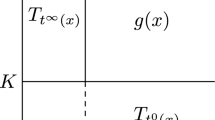Abstract
The Szegö–Widom theorem provides an expression for the determinant of block Toeplitz matrices in the asymptotic limit of large matrix dimension n. We show that the presence of zero modes, i.e, eigenvalues that vanish as \(\alpha ^n\), \(|\alpha |<1\), when \(n\rightarrow \infty \), requires a modification of the Szegö–Widom theorem. A new asymptotic expression for the determinant of a certain class of block Toeplitz matrices with one pair of zero modes is derived. The result is inspired by one-dimensional topological superconductors, and the relation with the latter systems is discussed.
Similar content being viewed by others
References
Böttcher, A., Silbermann, B.: Analysis of Toeplitz Operators, 2nd edn. Springer, Berlin (2006)
Widom, H.: Asymptotic behavior of block Toeplitz matrices and determinants II. Adv. Math. 21(1), 1 (1976)
Dubail, J., Santachiara, R., Emig, T.: Critical Casimir force between inhomogeneous boundaries. Eur. Phys. Lett. 112, 66004 (2015)
Dubail, J., Santachiara, R., Emig, T.: Conformal field theory of critical Casimir forces between surfaces with alternating boundary conditions in two dimensions. J. Stat. Mech. 2017, 033201 (2017)
McCoy, B., Wu, T.T.: Theory of Toeplitz determinants and the spin correlations of the two-dimensional ising model. Phys. Rev. 155, 438 (1967)
Szegö, G.: On Certain Hermitian Forms Associated with the Fourier Series of a Positive Function, pp. 223–237. Communications du Séminaire Mathématique de l’Université de Lund, Tome (1952)
Böttcher, A.: One more proof of the Borodin-Okounkov formula for Toeplitz determinants. Integr. Equ. Oper. Theory 41(1), 123 (2001)
Basor, E.L., Widom, H.: On a Toeplitz determinant identity of Borodin and Okounkov. Integr. Equ. Oper. Theory 37(4), 397 (2000)
Kitaev, A.: Unpaired Majorana fermions in quantum wires. Phys. Usp. 44, 131 (2001)
Kitaev, A.: Periodic table for topological insulators and superconductors. AIP Conf. Proc. 1134, 22 (2009)
Ryu, S., Schnyder, A.P., Furusaki, A., Ludwig, A.W.W.: Topological insulators and superconductors: tenfold way and dimensional hierarchy. New J. Phys. 12, 065010 (2010)
Kennedy, R., Zirnbauer, M.: Bott periodicity for \(\mathbb{Z}_2\) symmetric ground states of gapped free-fermion systems. Commun. Math. Phys. 342, 909 (2016)
Basor, E., Bleher, P.: Exact solution of the classical dimer model on a triangular lattice: monomer-monomer correlations. Commun. Math. Phys. 356(2), 397–425 (2017)
Acknowledgements
We would like to thank E. Ardonne, K. Kozlowski, J.-M. Stéphan and D. Vodola for inspiring discussions. This work was partly supported by the A*MIDEX Project ANR-11-IDEX-0001-02 cofunded by the French program Investissements d’Avenir, managed by the French National Research Agency.
Author information
Authors and Affiliations
Corresponding author
Appendix: More Examples of Block Toeplitz Matrices with \(E(\phi ) = 0\): Other Symmetry Classes of Topological Superconductors and Insulators
Appendix: More Examples of Block Toeplitz Matrices with \(E(\phi ) = 0\): Other Symmetry Classes of Topological Superconductors and Insulators
At this point, we would like to come back to Example 1. We note that it does not belong to symmetry class D because it has a symbol that is block anti-diagonal. In fact, in physics, there is another symmetry class for symbols like that in Example 1, called class BDI [10]. This class is the one of real anti-symmetric matrices A for which there exists a unitary matrix M that squares to the identity, \(M^2 = I_{Nn}\), such that
a property that encodes time-reversal symmetry. Such a property implies that, up to a change of basis, the symbol corresponding to A can be transformed in block anti-diagonal form
with \(B^* (e^{-i \theta }) = B(e^{i \theta })\). In class BDI, it is not Kitaev’s \(\mathbb {Z}_2\) invariant that decides whether or not there are pairs of zero modes. Instead, the number of such pairs is counted by the (absolute value of the) winding of \(\det B(e^{i \theta })\), which we denote as \(\mathcal {I}_\mathrm{BDI}\). The winding \(\mathcal {I}_\mathrm{BDI}\) is an arbitrary integer number, and so the number of pairs of zero modes can be larger than 1. For instance, consider the
Example 1b
Let u be a real number, and
The corresponding Toeplitz matrix
has determinant 1, for all u. For \(u \notin \{ 1,-1 \}\), one has \(\det \phi (\theta ) \, = \, 1 + u^2 -2 u \cos 2\theta > 0\). Kitaev’s \(\mathbb {Z}_2\) index is equal to \(\mathcal {I}_\mathrm{D} \, =\, +1\) but is does not provide sufficient information on the existence of zero modes. Instead, the proper index to use is \( \mathcal {I}_\mathrm{BDI}\), the winding of \(\det B (e^{i \theta }) = 1 - u e^{-i 2 \theta }\), which equals \(- 2\) if \(|u| > 1\). Therefore, there are two pairs of zero modes in this example, when \(|u|>1\).
The factorization corresponding to Example 2 in Sect. 1 also illustrates why there is difficulty with the original Szegö theorem. However here the special structure does allow one to find the formulas. Here is the factorization:
where
and
The above examples illustrate that, in order to determine whether a block-Toeplitz matrix has zero modes, one needs to carefully identify the symmetries of the matrix. Different symmetries will lead to different topological invariants that count the zero modes, and to different asymptotics of block-Toeplitz determinants. In the three example considered so far, we dealt with real antisymmetric matrices, related to 1d superconductors. Looking at the topological classification of topological insulators and superconductors in Refs. [10, 11], it is clear that there are other symmetry classes that host non-trivial topological phases of 1d insulators or superconductors (in 1d, those classes are: BDI, D, DIII, CII, AIII), and therefore are associated to block Toeplitz matrices with a particular structure that will correspond to cases where \(E(\phi ) = 0\) in the Szegö–Widom theorem.
We give one last example, related to a 1d insulator in symmetry class AIII. This is the class of hermitian matrices H that, up to a change of basis, are of block anti-diagonal form
Similarly to the class BDI, this may be viewed as a consequence of the existence of a unitary matrix M that squares to the identity, \(M^2 = I_{Nn}\), such that
a property often dubbed “chiral symmetry” or “sub-lattice symmetry” in physics. In class AIII, the number of pairs of zero modes is counted by the winding of \(\det B(e^{i \theta })\), which defines an index \(\mathcal {I}_{\mathrm{AIII}}\) that takes integer values. An example belonging to class AIII is the following.
Example 3
Let \(\zeta \in \mathbb {C}\), and
associated to the Toeplitz matrix
that has determinant 1. One has \(\det \phi ( \theta ) > 0\) for \(|\zeta | \ne 1\). It is easy to compute \(G(\phi )\) of the Szegö–Widom theorem; one finds \(G(\phi ) = \mathrm{max}[1, |\zeta |^2]\). Thus \(E(\phi )\) is in fact zero if \(|\zeta | > 1\). This is consistent with the observation that the index \(\mathcal {I}_\mathrm{AIII}\) (the winding of \(\det B(e^{i \theta })\)) equals \(-1\) for \(|\zeta |>1\).
The factorization for this example is almost identical to Example 1b except that \(2 \theta \) is replaced by \(\theta \). And as a final remark, the determinants of both of these examples follow from the remarks on page 5. Because of the specific structure of the matrices, both reduce to finding the asymptotics of two scalar functions with non-zero winding.
Rights and permissions
About this article
Cite this article
Basor, E., Dubail, J., Emig, T. et al. Modified Szegö–Widom Asymptotics for Block Toeplitz Matrices with Zero Modes. J Stat Phys 174, 28–39 (2019). https://doi.org/10.1007/s10955-018-2177-8
Received:
Accepted:
Published:
Issue Date:
DOI: https://doi.org/10.1007/s10955-018-2177-8




